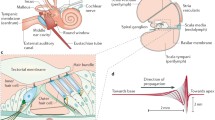Abstract
The antennal hearing organs of the fruit fly Drosophila melanogaster boost their sensitivity by an active mechanical process that, analogous to the cochlear amplifier of vertebrates, resides in the motility of mechanosensory cells. This process nonlinearly improves the sensitivity of hearing and occasionally gives rise to self-sustained oscillations in the absence of sound. Time series analysis of self-sustained oscillations now unveils that the underlying dynamical system is well described by a generalization of the van-der-Pol oscillator. From the dynamic equations, the underlying amplification dynamics can explicitly be derived. According to the model, oscillations emerge from a combination of negative damping, which reflects active amplification, and a nonlinear restoring force that dictates the amplitude of the oscillations. Hence, active amplification in fly hearing seems to rely on the negative damping mechanism initially proposed for the cochlear amplifier of vertebrates.





Similar content being viewed by others
References
Boekhoff-Falk G (2005) Hearing in Drosophila: development of Johnston’s organ and emerging parallels to vertebrate ear development. Dev Dyn 232:550–558
de Boer E (1996) Mechanics of the cochlea: modeling efforts. In: Dallos P, Popper A, Fay R (eds) The Cochlea. Springer Handbook of Auditory Research, Springer, Berlin Heidelberg New York
Camalet S, Duke T, Jülicher F, Prost J (2000) Auditory sensitivity provided by self-tuned critical oscillations of hair cells. Proc Natl Acad Sci USA 97:3183–3188
Chan DK, Hudspeth AJ (2005) Ca 2+ current-driven nonlinear amplification by the mammalian cochlea in vitro. Nat Neurosci 8:149–155
Choe Y, Magnasco MO, Hudspeth AJ (1998) A model for amplification of hair-bundle motion by cyclical binding of Ca 2+ to mechanoelectrical-transduction channels. Proc Natl Acad Sci USA 95:15321–15326
Duke T, Jülicher F (2003) Active traveling wave in the cochlea. Phys Rev Lett 90:158101-1–158101-4
Eguíluz VM, Ospeck M, Choe Y, Hudspeth AJ, Magnasco MO (2000) Essential nonlinearities in hearing. Phys Rev Lett 84:5232–5235
Gold T (1948) Hearing ii: the physical basis of the action of the cochlea. Proc R Soc Lond B 135:492–498
Göpfert MC, Robert D (2001) Active auditory mechanics in mosquitoes. Proc R Soc Lond B 268:333–339
Göpfert MC, Robert D (2003) Motion generation by Drosophila mechanosensory neurons. Proc Natl Acad Sci USA 100:5514–5519
Göpfert MC, Humpfries ADL, Albert JT, Robert D, Hendrich O (2005) Power gain exhibited by motile neurons in Drosophila ears. Proc Natl Acad Sci USA 102:325–330
Jülicher F, Andor D, Duke T (2001) Physical basis of two-tone interference in hearing. Proc Natl Acad Sci USA 98:9080–9085
Kennedy HJ, Crawford AC, Fettiplace R (2005) Force generation by mammalian hair bundles supports a role in cochlear amplification. Nature 433:880–883
Kern A, Stoop R (2003) Essential role of couplings between hearing nonlinearities. Phys Rev Lett 91:128101-1–128101-4
Kern A, Steeb W-H, Stoop R (2000) Projective noise cleaning with dynamic neighborhood selection. Int J Mod Phys C 11:125–146
Kuramoto Y (2003) Chemical oscillations, waves, and turbulence. Dover Publications, Dover
Magnasco MO (2003) A wave traveling over a Hopf instability shapes the cochlear tuning curve. Phys Rev Lett 90:058101-1–058101-4
Martin P, Mehta AD, Hudspeth AJ (2000) Negative hair-bundle stiffness betrays a mechanism for mechanical amplification by the hair cell. Proc Natl Acad Sci USA 97:12026–12031
Robert D, Göpfert MC (2002) Novel schemes for hearing and orientation in insects. Curr Opin Neurobiol 12:715–720
Robles L, Ruggero M (2001) Mechanics of the mammalian cochlea. Physiol Rev 81:1305–1352
Savitsky A, Golay MJE (1964) Smoothing and differentiation of data by simplified least square procedures. Anal Chem 36:1627–1639
Sisto R, Moleti A (1999) Modeling otoacoustic emissions by active nonlinear oscillators. J Acoust Soc Am 106:1893–1906
Stoop R, Kern A (2004) Two-tone suppression and combination tone generation as computations performed by the Hopf cochlea. Phys Rev Lett 93:268103-1–268103-4
Author information
Authors and Affiliations
Corresponding author
Rights and permissions
About this article
Cite this article
Stoop, R., Kern, A., Göpfert, M.C. et al. A generalization of the van-der-Pol oscillator underlies active signal amplification in Drosophila hearing. Eur Biophys J 35, 511–516 (2006). https://doi.org/10.1007/s00249-006-0059-5
Received:
Revised:
Accepted:
Published:
Issue Date:
DOI: https://doi.org/10.1007/s00249-006-0059-5




